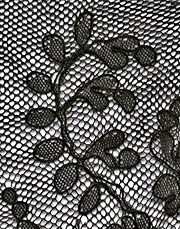.gif)
Gimp (thread)
Encyclopedia
Gimp is a narrow ornamental trim
used in sewing or embroidery. It is made of silk
, wool
, or cotton
and is often stiffened with metallic wire or coarse cord running through it. Gimp is used as trimming for dresses, curtains, furniture, etc. Originally the term referred to a thread with a cord or wire in the center, but now is mainly used for a trimming braided or twisted from this thread. Sometimes gimp is covered in beads or spangles.
The term "gimp" for a braided trim has been around since the 15th and 16th centuries, when gimp threads were braided into flat braids up to a quarter of an inch (7 mm) wide. The braids were sometimes made either with bobbins or needle and thread, which gave greater control over the threads. Gimp trim was then sewn down to form designs.
The name "gimp" has also been applied to the plastic thread used in the knotting and plaiting craft scoubidou
.

 The term gimp with reference to lace refers to the thread that is used to outline the pattern. This thread is normally thicker than that used to make the lace. It gives definition and slightly raises the edge of the design. A gimp thread is used widely in many laces, with notable exceptions being Binche lace
The term gimp with reference to lace refers to the thread that is used to outline the pattern. This thread is normally thicker than that used to make the lace. It gives definition and slightly raises the edge of the design. A gimp thread is used widely in many laces, with notable exceptions being Binche lace
and Valenciennes lace
.
The terms gimp and cordonnet can, for the most part, be used interchangeably, as both are defined as the thread that forms the outline of the design. The term "cordonnet" is used particularly when the outline is padded and when the thread is completely on the surface of the lace. When the thread is made of more than one strand (as in Chantilly lace
), it is also called a cordonnet. In machine-made laces the outlining thread is always called a cordonnet.
Trim (sewing)
Trim or trimming in clothing and home decorating is applied ornament, such as gimp, passementerie, ribbon, ruffles, or, as a verb, to apply such ornament....
used in sewing or embroidery. It is made of silk
Silk
Silk is a natural protein fiber, some forms of which can be woven into textiles. The best-known type of silk is obtained from the cocoons of the larvae of the mulberry silkworm Bombyx mori reared in captivity...
, wool
Wool
Wool is the textile fiber obtained from sheep and certain other animals, including cashmere from goats, mohair from goats, qiviut from muskoxen, vicuña, alpaca, camel from animals in the camel family, and angora from rabbits....
, or cotton
Cotton
Cotton is a soft, fluffy staple fiber that grows in a boll, or protective capsule, around the seeds of cotton plants of the genus Gossypium. The fiber is almost pure cellulose. The botanical purpose of cotton fiber is to aid in seed dispersal....
and is often stiffened with metallic wire or coarse cord running through it. Gimp is used as trimming for dresses, curtains, furniture, etc. Originally the term referred to a thread with a cord or wire in the center, but now is mainly used for a trimming braided or twisted from this thread. Sometimes gimp is covered in beads or spangles.
The term "gimp" for a braided trim has been around since the 15th and 16th centuries, when gimp threads were braided into flat braids up to a quarter of an inch (7 mm) wide. The braids were sometimes made either with bobbins or needle and thread, which gave greater control over the threads. Gimp trim was then sewn down to form designs.
The name "gimp" has also been applied to the plastic thread used in the knotting and plaiting craft scoubidou
Scoubidou
Scoubidou is a plaiting and knotting craft, originally aimed at children. It originated in France, where it became a fad in the late 1950s and has remained popular...
.
In lace


Binche lace
Binche lace is a Flemish bobbin lace that originated in Binche, Belgium. It is continuous, meaning it is made all at once, in one piece. It is generally made in strips 2 inches wide. Though typically it has no cordonnet outlining the design against the ground, occasional pieces are made with a...
and Valenciennes lace
Valenciennes lace
Valenciennes lace is a type of bobbin lace which originated in Valenciennes, in the Nord département of France, and flourished from about 1705 to 1780. Later production moved to Belgium in and around Ypres. The industry continued onto the 19th century on a diminished scale...
.
The terms gimp and cordonnet can, for the most part, be used interchangeably, as both are defined as the thread that forms the outline of the design. The term "cordonnet" is used particularly when the outline is padded and when the thread is completely on the surface of the lace. When the thread is made of more than one strand (as in Chantilly lace
Chantilly lace
Chantilly lace is a handmade bobbin lace named after the city of Chantilly, France, in a tradition dating from the 17th century, though the most famous are silk laces introduced in the 18th century...
), it is also called a cordonnet. In machine-made laces the outlining thread is always called a cordonnet.

